Australia is home to one-sixth of the world’s parrots. Out of 330 parrot species that inhabit our planet, 56 are found in Australia. With their stunning looks and entertaining behaviour, parrots are some of the most famous Australian birds.
Most parrots are specialist seed-eaters – their powerful short beaks are well suited for tearing apart seedpods and nuts. Although some species, like lorikeets, feed primarily on nectar and pollen.
Australia’s geographic isolation allowed the parrots to diversify into a huge array of species and to colonize every corner of the continent in the absence of other large seed-eating birds. As a result, parrots are found in most Australian habitats from the arid inland regions to the forested coast.
Many species of Australian parrots adapted well to the urban environment and can be found throughout Sydney suburbia. Below is the list of the common and not-so-common species of Sydney parrots and a guide on where to see parrots in Sydney.
And here’s a fun bit of trivia – a collective noun used for a group of parrots is ‘pandemonium’. So enjoy spotting a pandemonium of parrots in Sydney!
Sulphur-crested Cockatoo
The most conspicuous parrot in Sydney is the Sulphur-crested Cockatoo. One of the most common birds in Sydney, they can be spotted virtually anywhere, even in the city center. Their harsh loud call is usually the first giveaway of their presence in the area.
But if you would like to watch them in a natural setting, head to the Royal Botanic Gardens. Late in the afternoon, they congregate on the grassy lawns near the Palm Grove Center. They are, no doubt, the most entertaining cockatoos in Sydney. Watch them fool around with each other and play with sticks they find in the grass.
Yellow-tailed Black Cockatoo
A much rarer sight, the Yellow-tailed Black Cockatoo, is one of the most beautiful Australian parrots. They are the largest parrots in Sydney and some of the loudest. They travel in large noisy flocks flying on the slowly flapping wings.
Like all parrots, the Yellow-tailed Black Cockatoo nest in tree hollows and the large hollow-bearing trees are becoming scarce as more and more land is cleared. It can take 200-250 years for a large enough hollow to form, so once these trees are gone, they can not just be re-planted.
Centennial Park, despite its proximity to the city centre, has retained a number of large, old trees and it is a good spot to look for the black cockatoos. They can often be found feeding on fallen pinecones in large flocks.
To find them in the park, head for the strands of pine trees along the Grand Drive and listen for their calls that sound like this.
Another good place for spotting Yellow-tailed cockatoos is the Royal National Park. Mostly you and see (and hear) them as they fly above you, but quite often you can find them perched in the trees on the sides of the trails, like the Curra Moors track.
Little Corella & Long-billed Corella
Corellas can sometimes be mistaken for the Sulpher-crested Cockatoos in flight, even though they are quite different birds. They are considerably smaller and their crests are not as elaborate. There are two species of Corellas that visit Sydney: Long-billed Corella and Little Corella.
Historically, Corella’s habitat did not extend to Sydney, but with continuous habitat alteration the birds’ distribution range is changing and they can now be often seen in Sydney suburbs. They are often found foraging in large flocks on the ground.
The good places to see both species of Corellas are the campgrounds in Royal National Park, Kur-rin-gai Chase and the Blue Mountains, like the Euroka clearing.
Galah
Galah, also known as the Rose-breasted Cockatoo, is the most common parrot in Australia and its numbers are increasing in response to land clearing. Like the Corellas, Galah used to be confined to the dry open areas in the interior of the country, and now it can be found even along the coast, including the urban areas.
An interesting fact about Galahs is that they form life-long bonds. And with a lifespan of 40 years, that’s quite a commitment.
In Sydney, you can find them in the Centennial Park, Dangar Island, Mt Annan Botanic Gardens and most of the suburbs on the leafy North Shore.
Gang-gang Cockatoo
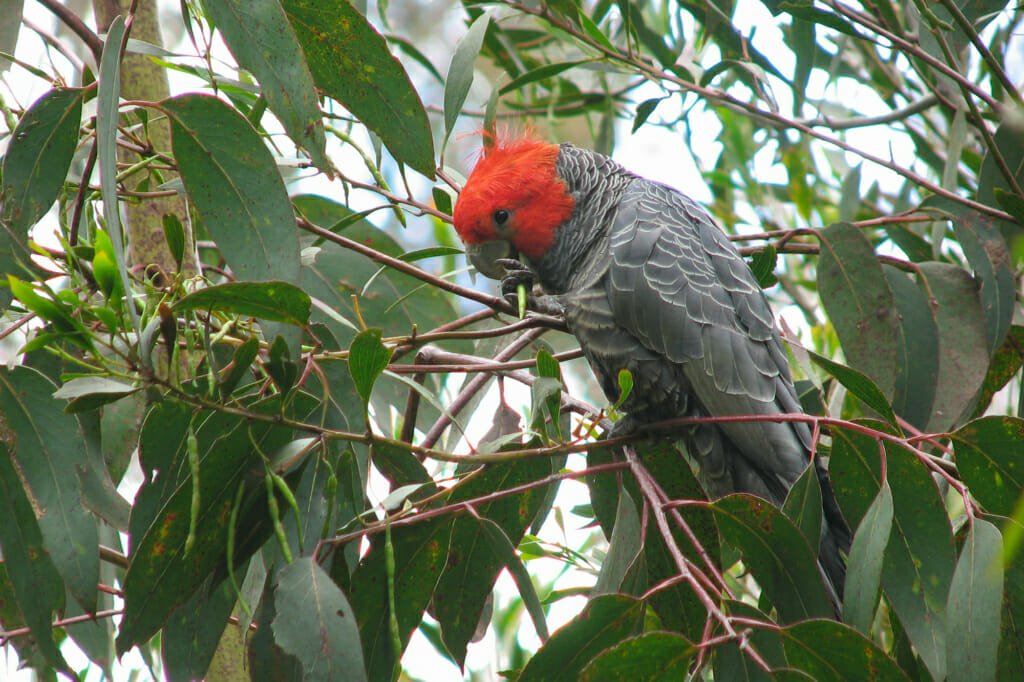
Gang-gang Cockatoo is the only grey-coloured cockatoo in Sydney. The male of the species has a distinctive red head and crest, while the female is uniform grey.
They used to be common in Sydney, but over the last two decades, they all but disappeared. The last remaining breeding population of Gang Gangs in the Sydney Metropolitan region is restricted to Hornsby and Kur-rin-gai area. This population contains only 18-40 breeding pairs and has been listed as Endangered since 2001.
Now you have to venture further out to see Gang Gangs. During the summer, you can find them in the mountains in the tall forests and woodlands. A good place to look for them is the Blue Mountains Botanic Garden at Mount Tomah and around Blackheath.
In winter months, they move to lower altitudes and can sometimes be seen in suburban parks and gardens in the mountains. They are one of the quieter cockatoo species and can usually be located by their soft chirping and the fallen debris, as they feed.
Rainbow Lorikeet
The most common parrot in Sydney, the Rainbow Lorikeet is arguably the most beautiful one. With bright greens, blues, yellows and orange in their plumage, Rainbow Lorikeets look like flying rainbows. They usually congregate in tight chattering flocks and flutter around from tree to tree feeding on nectar.
Rainbow Lorikeets are a common sight in Sydney suburbia and national parks alike. City parks, like the Centennial Park and the leafy suburbs, are good spots to watch these colourful birds.
In winter, when nectar supply is limited, lorikeets become creative in their search for food. We occasionally have a pair of Rainbow Lorikeets knock on our balcony door and when let in, they boldly hop into our living room and wait to be fed.
But please keep in mind, that while feeding the lorikeets may seem like a compassionate thing to do, doing this habitually is harmful to the birds and in the worst case, can even kill them.
Crimson Rosella
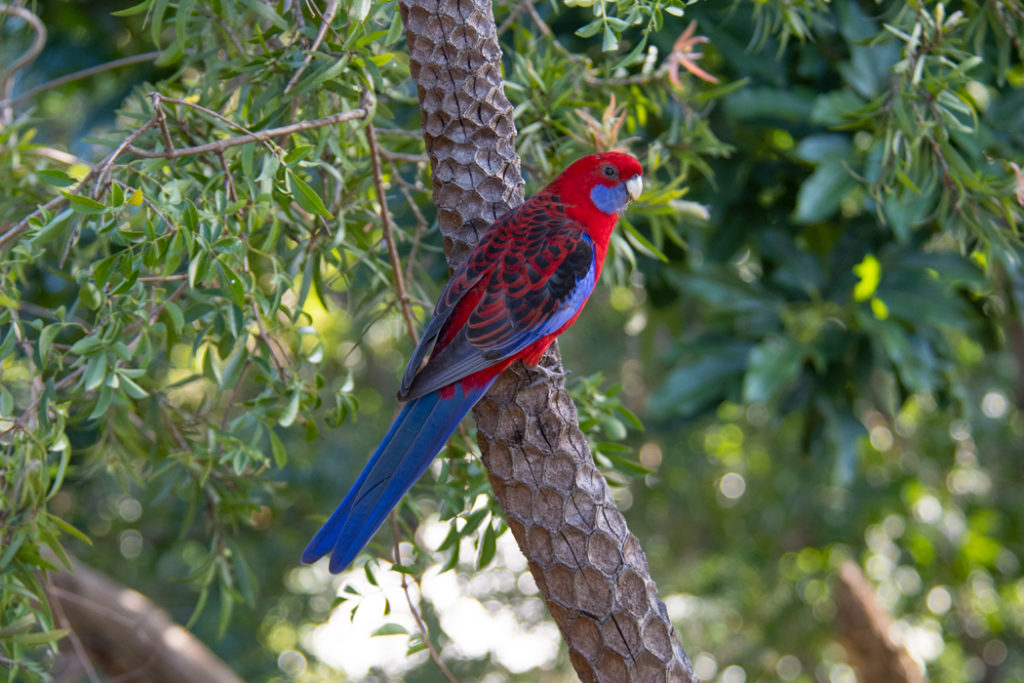
Another stunningly coloured parrot in Sydney is the Crimson Rosella. They are quite common in forested areas of Sydney. You can see them in the Blue Mountains, at Mt Annan Botanic Gardens and in Royal National Park. The suburbs adjacent to Royal National Park (Helensborough & Ottford) are also good places to look for Crimson Rosellas. They can often be seen on the ground feeding on seeds in small flocks.
Eastern Rosella
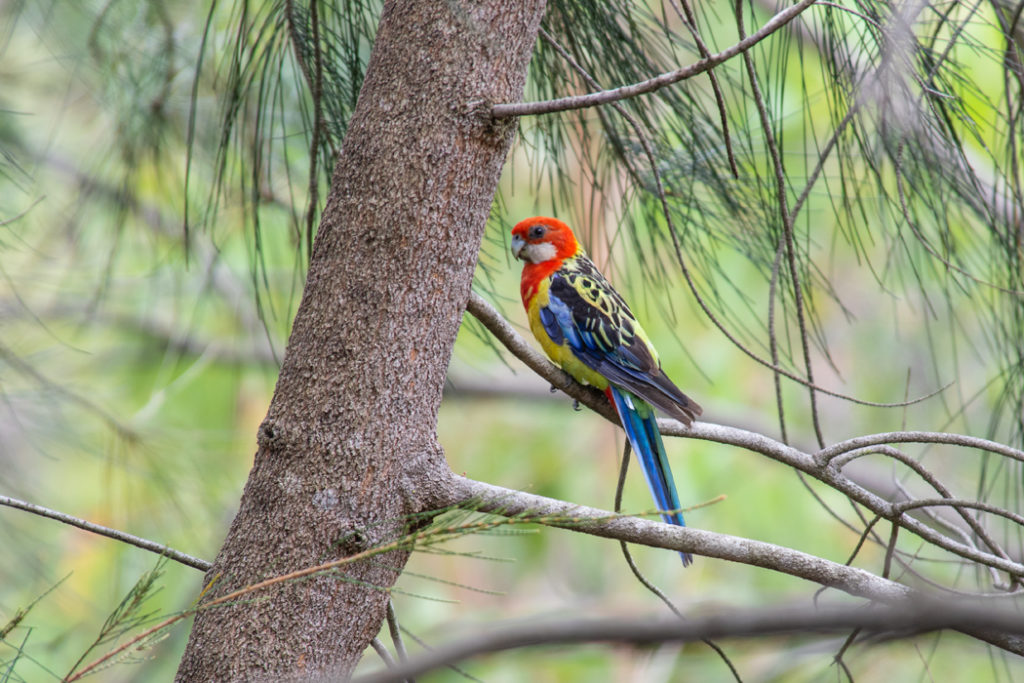
A slight variation on the rosella theme, the Eastern Rosella is quite similar to the Crimson Rosella. It is one of the most brilliantly-coloured Sydney parrots. The easiest way to distinguish it from its crimson cousin is by its bright white cheeks (Crimson Rosella has light blue cheeks).
The Eastern Rosella is reasonably common in Sydney and can often be seen in Centennial Park. But the best place to see them is Mt Annan Botanic Gardens and Dangar Island on the Hawkesbury River. Although despite their vivid colouration they can be difficult to spot – their patterned plumage keeps them well camouflaged among the leaves. You will probably spot them when they fly across your field of view.
Red-rumped Parrot
Red-rumped parrots are quite common around Sydney, but they are often missed because they feed on the ground. This year, a pair appeared in Glebe’s Black Wattle Bay and spent days working their way through the grass seeds with surprising determination.
They typically forage in pairs or small flocks, and can often be spotted in feeding flocks, among the rosellas and galas. A good place to see the Red-rumped parrot in Sydney is Mt Annan Botanic Gardens. They are also often seen at the Sydney Olympic Park. Once located, they are easy to watch. When disturbed, the Red-rumped parrots fly up to the nearest tree and soon return to the ground to continue feeding.
Australian King Parrot
An elusive parrot of the dense forest, the Australian King Parrot will not be as easy to spot as the other species. It prefers to stay within the confines of the forest, where it feeds on seeds and fruit up in the trees. It even flies below the treetops, which makes it harder to find.
By far, the best place in Sydney to see King parrot is Dangar Island. This small island has a large breeding population of King parrots and they are very easy to spot here. There are also some unusual yellow-coloured male King Parrots on the island. The experts believe that this is due to a genetic condition known as Leucism, in which there is a partial loss of pigmentation resulting in pale or white feathers, depending on the other pigments present.
Another good spot to see King parrots is Katoomba in the Upper Blue Mountains, particularly near the Scenic World. The staff at the visitor centre used to provide bird feeders and the area became a pretty reliable spot for the parrots. For the best chances, take the walk from the Three Sisters to the Scenic World and scan for bright splashes of colour in the trees as you walk along.
Another fantastic spot for King parrots is a little further away – the gorgeous Kangaroo Valley. There is a bird feeder at Cambewara Mountain Lookout where you get to see King parrots and Crimson rosellas against the background of one of the most expansive views in NSW.
Musk Lorikeet
Musk Lorikeet is a handsome bird with mostly green plumage and a bright red cap and band through the eye. It is a nomadic species that follows the flowering eucalypt trees in search of nectar. They are found in tall, dry open eucalypt woodlands, where they feed up in the canopy.
Because it moves around so much it’s not as easy to find as the Rainbow Lorikeet. Good places to look for the Musk Lorikeet are Royal National Park in the south of Sydney, Mt Annan Botanic Gardens in the west, and Kur-rin-gai Chase and Dangar Island in the north.
Scaly-breasted lorikeet
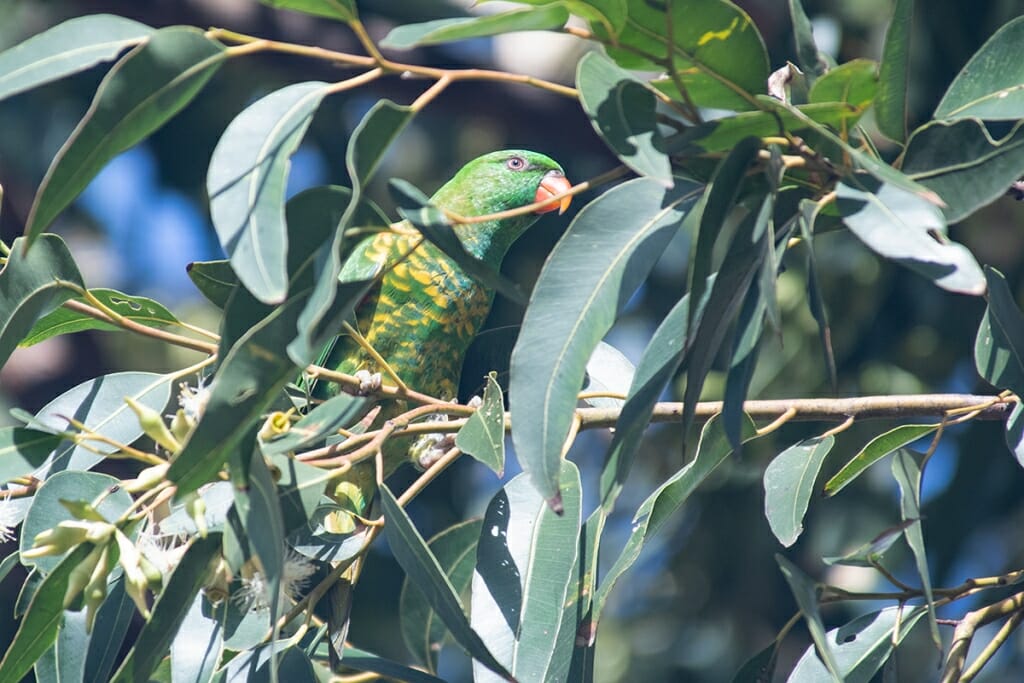
Another lorikeet you can spot in the mixed feeding flocks with Rainbow and Musked lorikeets is the Scaly-breasted lorikeet. It is easily recognizable by its all-green head and red beak. Its breast and neck are marked with yellow ‘scales’ which give the bird its name.
It occurs across the coastal region of eastern Australia and can sometimes be spotted in urban parks and gardens. They feed on flowering eucalypts and umbrella trees, usually staying inside the canopy to avoid being harassed by the larger and more aggressive Rainbow lorikeets. And because of their cryptic habits, they can be tough to spot.
Little Lorikeet
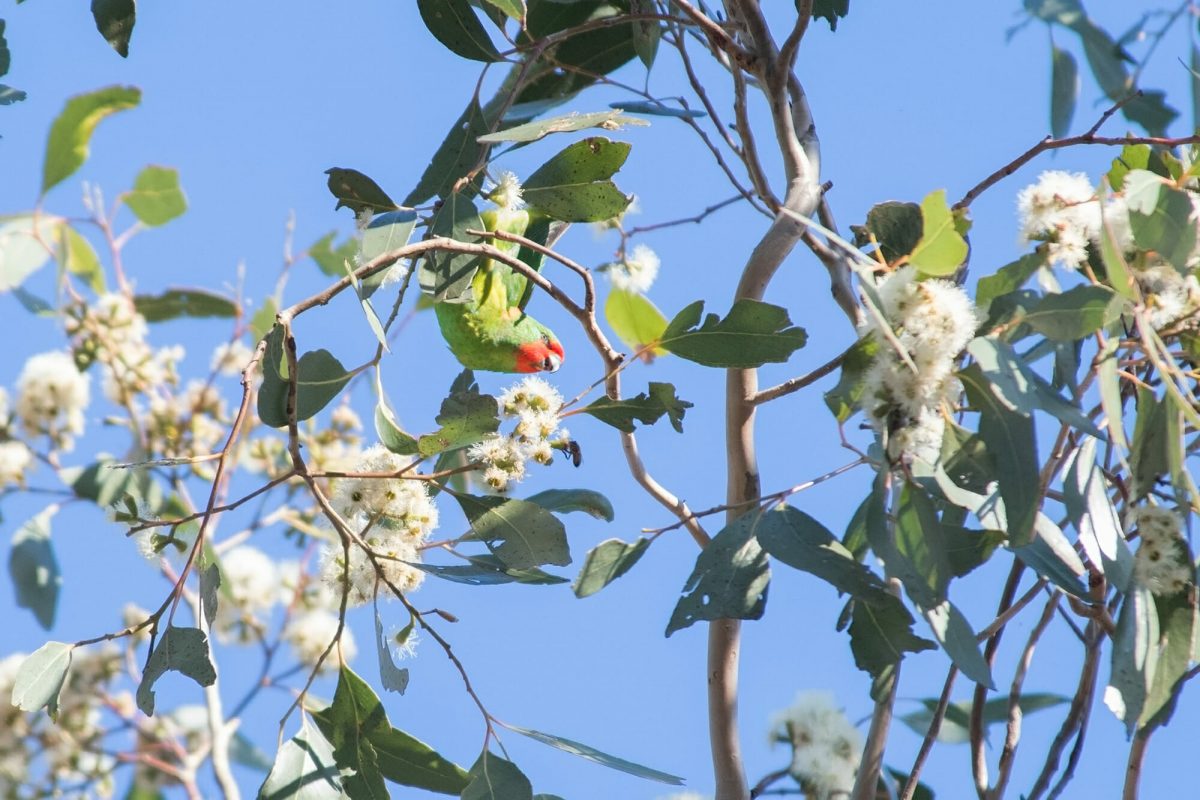
As the name suggests, the Little Lorikeet is the smallest of Australia’s lorikeets. These tiny birds can be difficult to spot – they are mostly leaf-green and are not much bigger than the leaves among which they feed. And they like to feed on flowers at the top of the tall eucalypts.
They often forage in mixed flocks with Rainbow and Musk Lorikeets. Apart from their size, they are distinguished from the Musk Lorikeets by their short pointed tails and the lack of red ear cover.
The only place I saw Little Lorikeets in Sydney was in Mt Annan Botanic Gardens, near the visitor centre. But they are an easy species to miss, so they could be present at other birdwatching hotspots in Sydney. Their call is helpful in finding the birds themselves.
Swift Parrot

As you explore the green corners of Sydney, keep an eye out for the Critically Endangered Swift Parrot in the winter months. They are infrequent visitors, but you never know your luck in a big city.
Sadly, it is estimated that there are no more than 2000 Swift Parrots left in South-Eastern Australia, making them one of the rarest Australian parrots. This attractive parrot breeds in Tasmania in summer and migrates to the mainland in winter. And ironically, one of the biggest threats to its survival (apart from habitat loss) is predation by one of Australia’s cutest possums – the Sugar Glider.
To recognize the Swift Parrot, look for the red forehead and throat and a blue patch on the crown on the mostly green body.
Finding Swift Parrots in Sydney will be a tough job – these birds are nomadic and spend their winter following the flowering trees. They are occasionally spotted in Royal National Park.
This year four Swift parrots stayed for a week at Mt Annan Botanic Gardens. And of all the native vegetation in the 416-hectare garden, they insisted on staying in the area occupied by the colony of aggressively territorial Bell Miners. I watched the parrots being dive-bombed by the miners, but they remained in the area, despite the constant harassment.
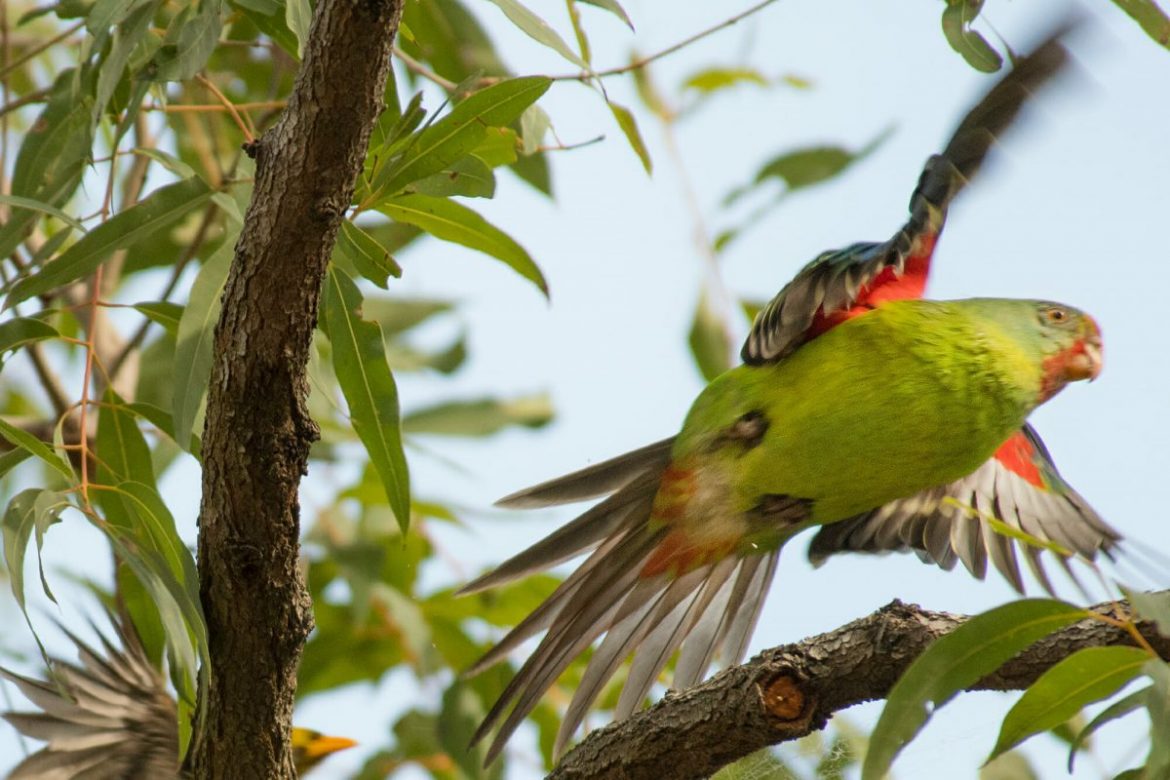
As canopy feeders, Swift parrots are tricky to photograph. I stayed with the four birds in the garden for almost 3 hours, waiting for them to descend to the lower level of vegetation, but each time they did, the Bell miners chased them away.
Best bird watching spots in Sydney (for parrots)
Dangar Island
This little-known island on the Hawkesbury River, about 50km from the centre of Sydney is by far, the best place in Sydney to see different species of parrots. Hundreds of Rainbow lorikeets, dozens of Sulphur-crested cockatoos, plenty of King parrots, Galahs, Eastern Corellas call Dangar Island home. Musk lorikeets also visit in the colder months.
The island also has an exploding population of Noisy miners which seem to have outcompeted all other birds that are smaller than them. As a result, the only birds on the island, apart from the miners are the parrots & some larger species like Magpies and Kookaburras.
Centennial Parklands
Located just minutes from the centre of Sydney, the Centennial Parklands are made up of three large urban parks with a combined area of 360 hectares. The parklands are a mosaic of open spaces and wooded areas, with an impressive 15,000 trees.
The parklands are the best spot for birdwatching in the Sydney Metropolitan area and a great spot to see the Yellow-tailed black cockatoos. Other parrots in the parklands include the Rainbow lorikeets, Sulpher-crested cockatoos and Galahs.
Royal Botanical Gardens
The Royal Botanical Gardens are located in the heart of Sydney in the spectacular waterfront location. They are home to a number of waterbird species and good numbers of Rainbow lorikeets and Sulphur-crested cockatoos. The cockatoos in the gardens are used to people and can often be watched at a close range. A little bit too close at times when they hop onto people’s arms and heads.
Mt Annan Botanic Gardens
The Australian Botanic Garden Mount Annan is an outstanding birdwatching spot an hour’s drive west of Sydney CBD. Covering 416 hectares, it is the largest botanical garden in Australia, home to over 4000 species of native plants.
All this native vegetation attracts a phenomenal amount of birds – more than 200 species have been recorded in the gardens, which makes it one of the best spots for bird watching in Sydney.
I have seen five species of parrots in a single flowering tree, near the park’s entrance. There are Sulphur-crested cockatoos, Galahs, Eastern rosellas, Rainbow lorikeets, Musk lorikeets, Red-rumped parrots and Little lorikeets in the gardens. The endangered Swift parrot has been recorded in the gardens twice, including sightings in June this year.
Royal National Park
Only an hour’s drive (or train ride) from Sydney, Royal National Park is one of the most scenic wild escapes out of Sydney and one of the best spots where you can see parrots in Sydney. Apart from the spectacular coastal scenery, the park is home to over 300 native bird species – the highest number for any protected area in New South Wales.
Rainbow lorikeets, Sulphur-crested cockatoos and Crimson Rosellas are all common in the park. It is also a good place to look for Musk lorikeet and even an occasional Swift Parrot.
Blue Mountains
The Blue Mountains are slightly further afield than the places above. The upper mountains that contain the towns of Leura and Katoomba are reached by about a 2-hours drive or train ride. The towns are set among 11,400 square kilometres of rugged wilderness that is home to an incredible variety of wildlife species.
The trails around Katoomba are good for spotting King Parrot and Crimson Rosella. Leura is a good place to look for Gang-gang cockatoos. Of the more common species, there are plenty of Rainbow lorikeets and Sulphur-crested cockatoos.
The lower Blue Mountains are good for spotting large flocks of Corellas, particularly the areas around Glenbrook.
What are your favourite spots to see parrots in Sydney? Please share your tips in the comments.
Recommended Australian Bird Guide
For help with identifying parrots, pick up a copy of a bird guide. The best guide to Australian birds is Peter Menkhorst’s The Australian Bird Guide.
More on Finding Wildlife in Sydney
- Finding Fireflies and Glow Worms in the Blue Mountains
- Humpback whale migration – the greatest wildlife spectacle in Sydney
- Wildlife in Sydney – A guide to finding wildlife in and around Sydney
- Where to See Parrots in Sydney
- Migratory waders and other birds in Sydney Olympic Park
- Kangaroos, cockatoos and a riverside walk at Euroka campground
- Spotting Wildlife in the Watagans
- Birds and frogs of Smiths lake

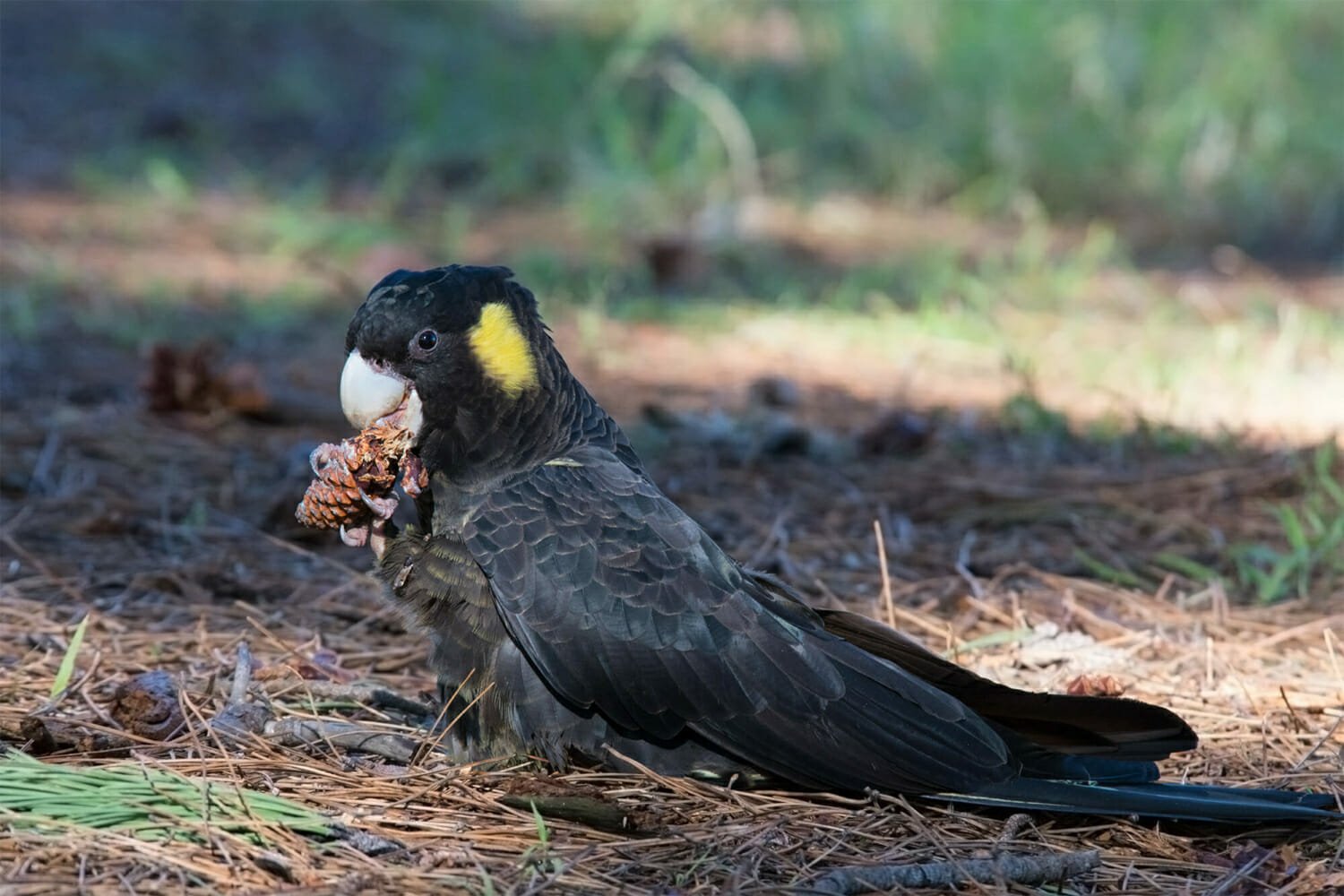
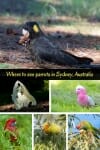
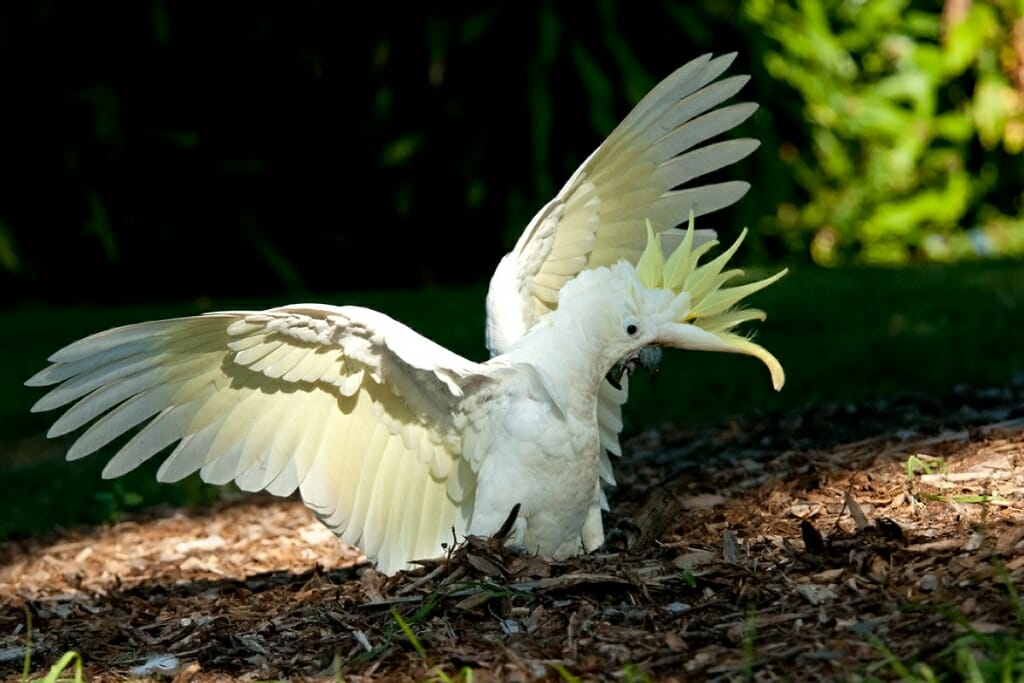
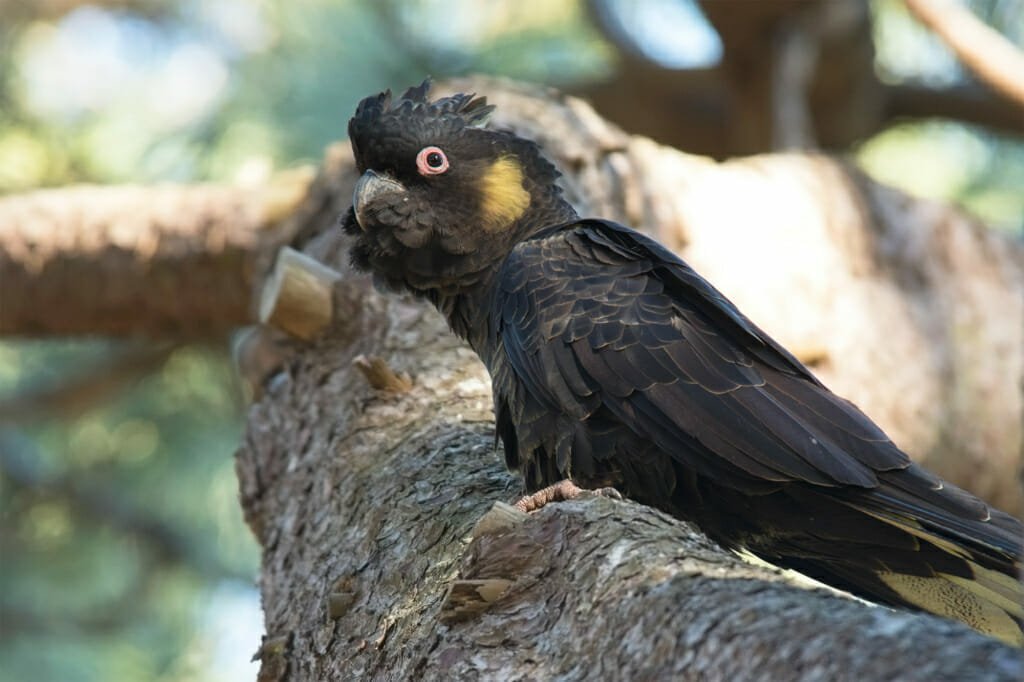
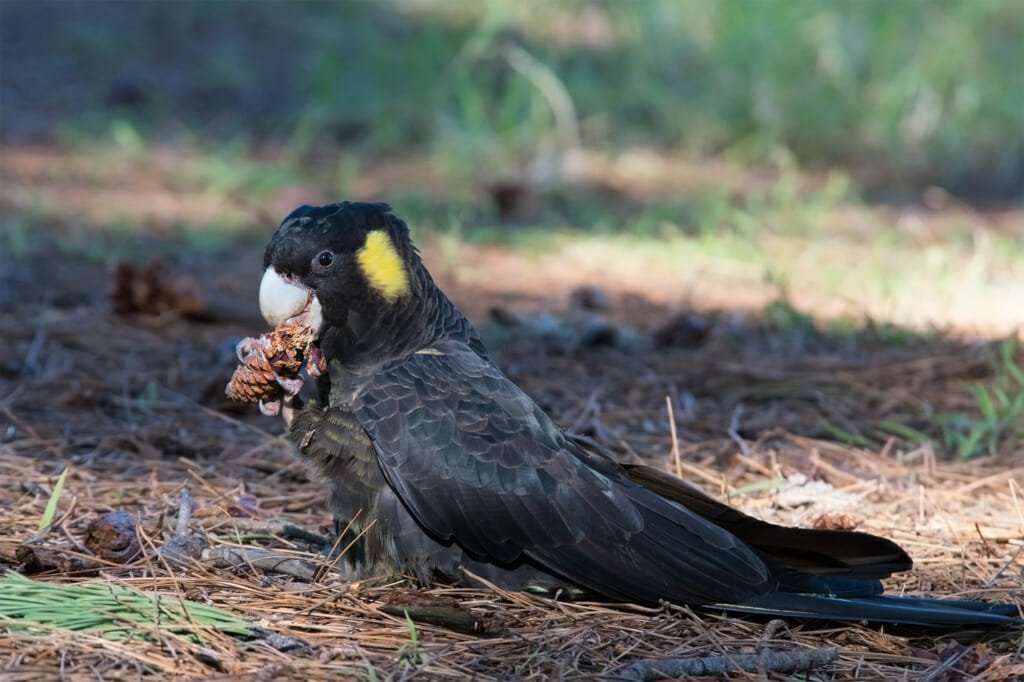
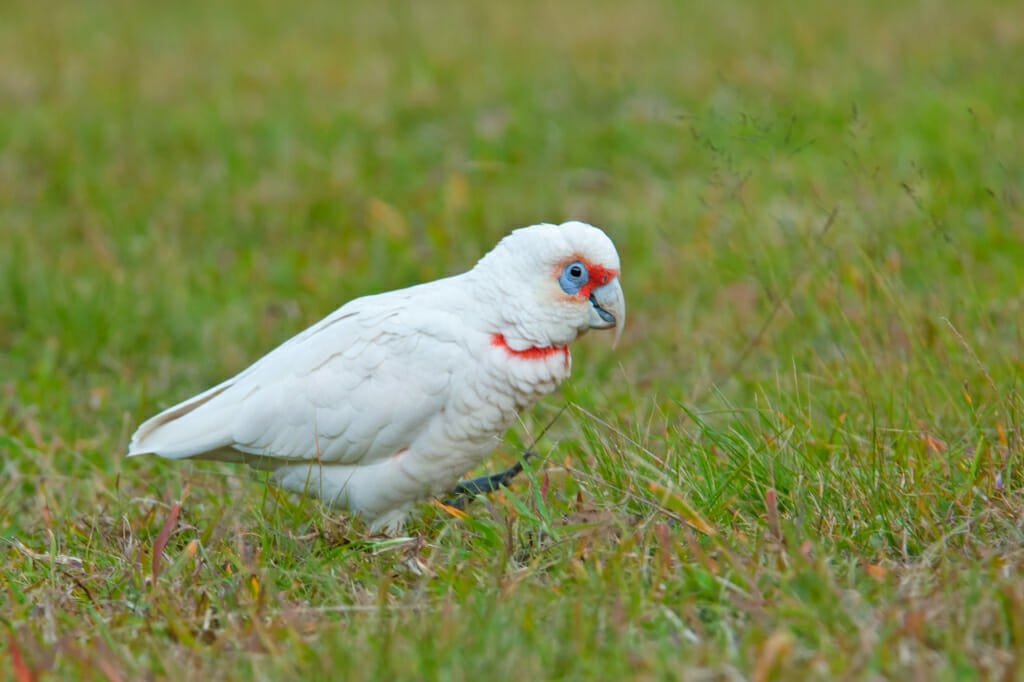
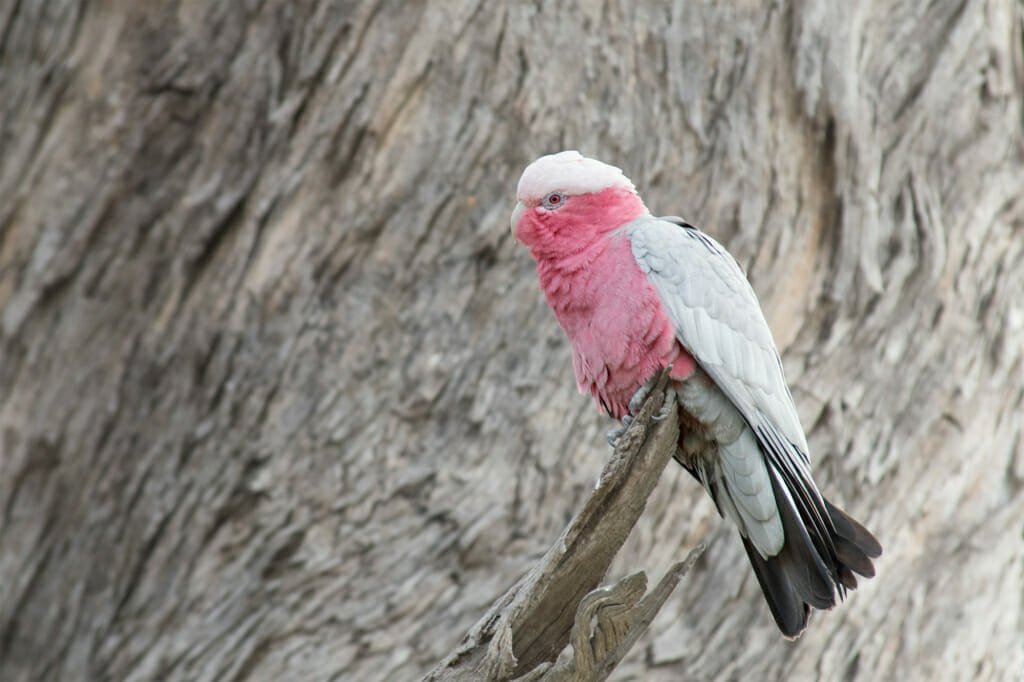
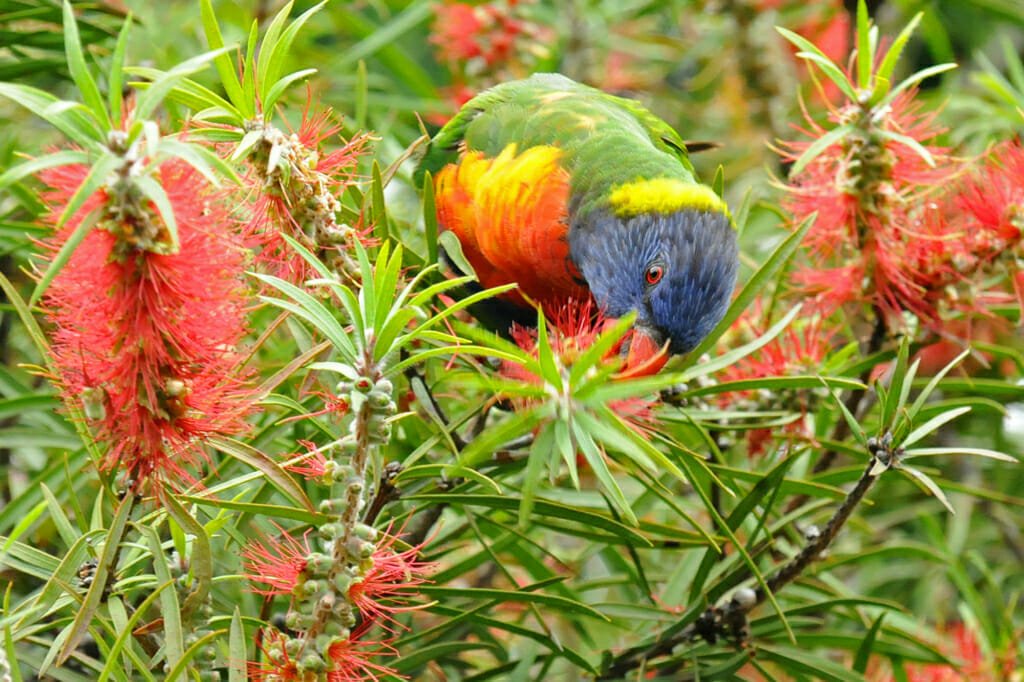
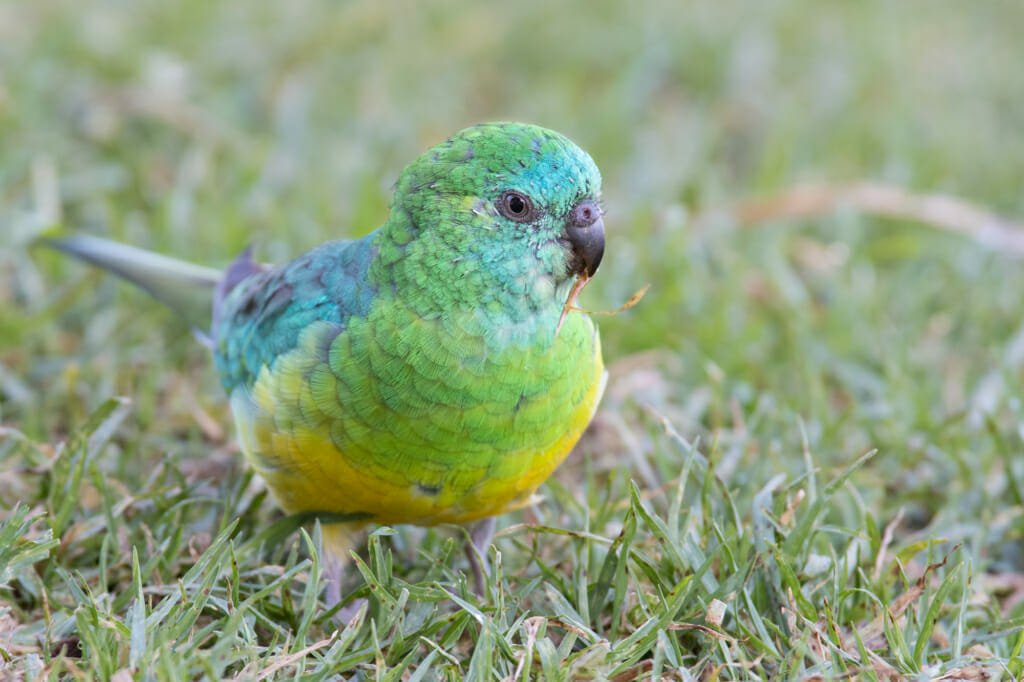
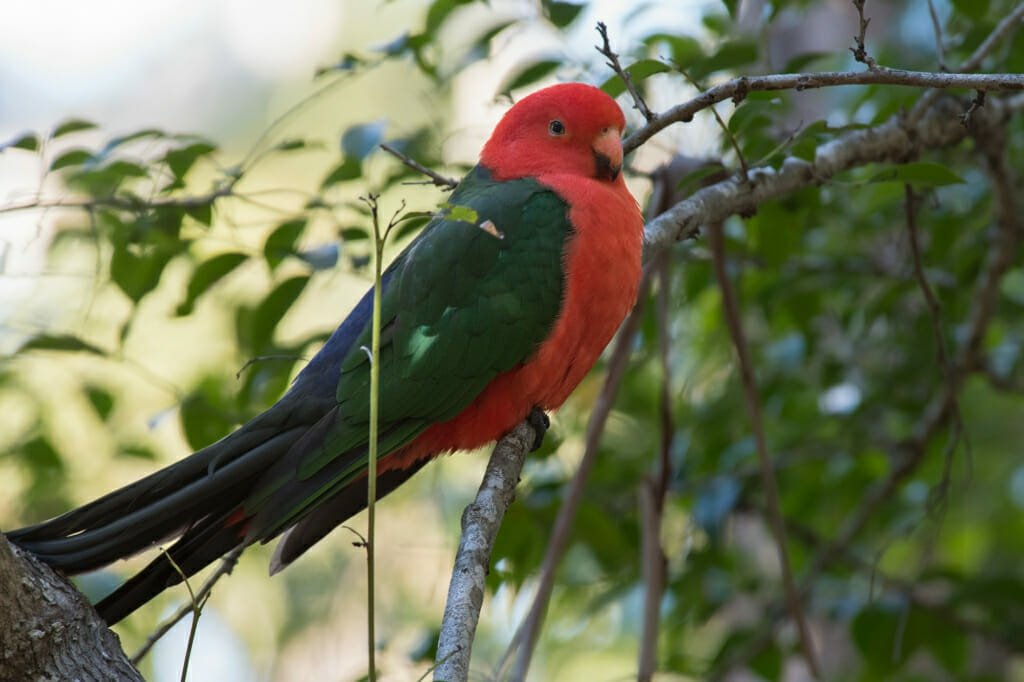
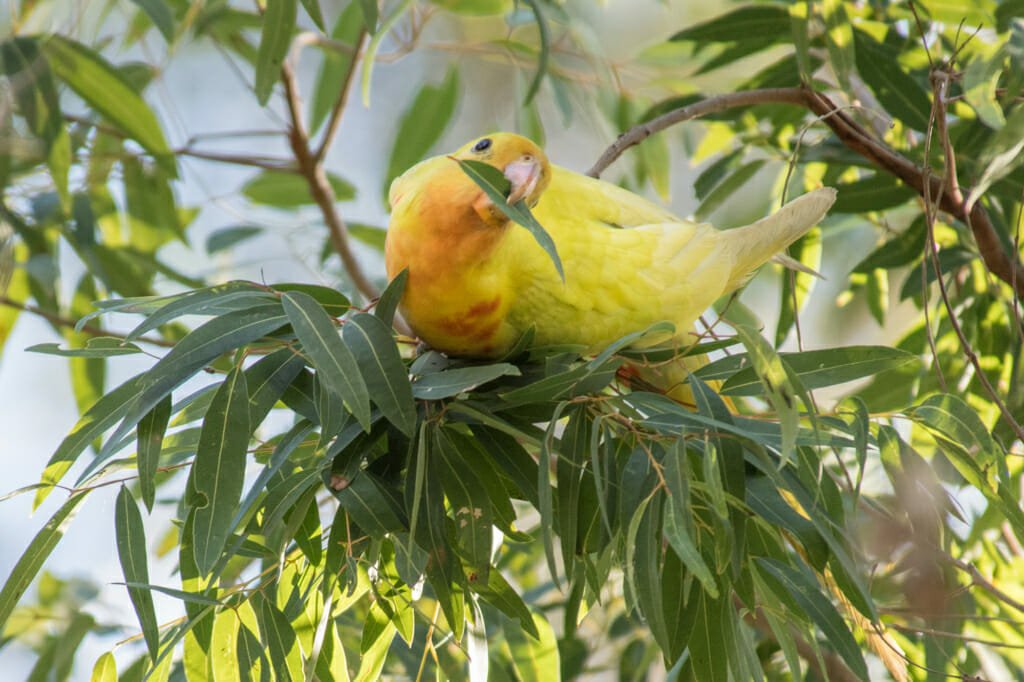
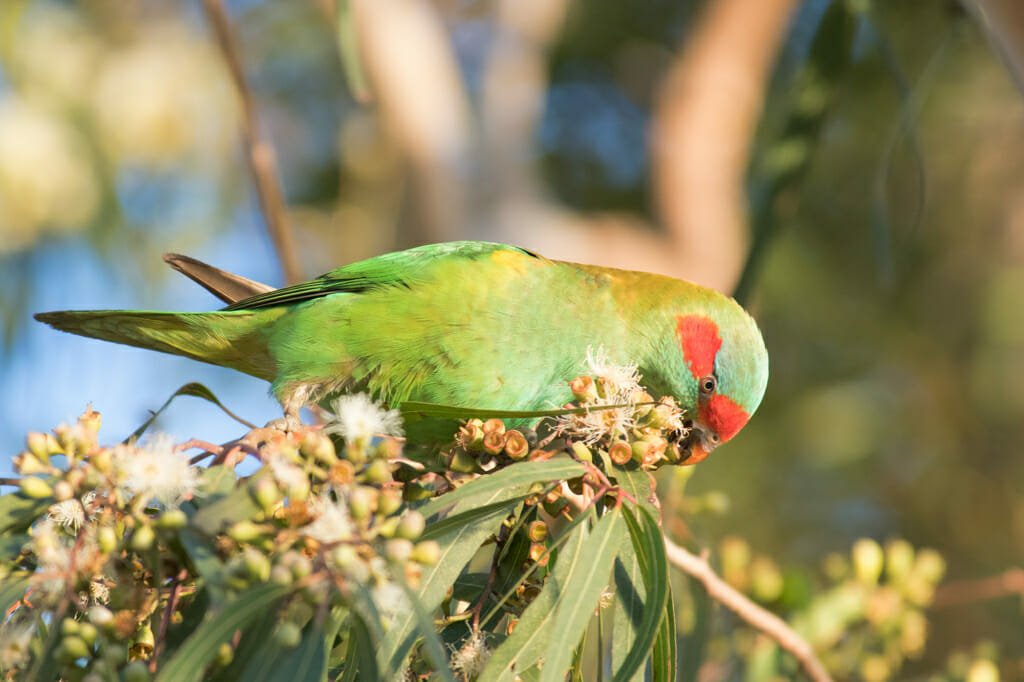

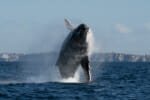
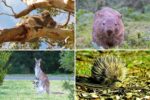
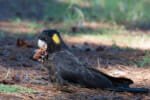
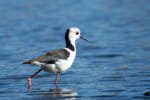
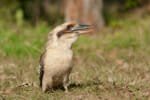
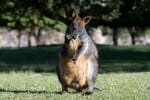

Love parrots and enjoy hearing their chatty calls and vibrant colours. Increasingly seeing flocks of yellow tailed black cockatoos in Ramsgate and Dolls Pt areas. Also regularly spot King parrots in Oatley and Lugarno.
Oh that’s interesting about the yellow tails. They are such fabulous birds to observe
Does anyone know where a family photo might have been taken in the mid 1960’s… where there were Lorakeets on public display, a miniature train and food stalls in the hills? NSW or QLD at a tourist park.?
I have the photo. DM welcome.
Oooh, virtually anywhere in Australia. Do you know which lorikeets?
Hello, this evening I saw my first Yellow Tailed Black Cockatoos. 3 of them chewing up the cones in the top of a huge old Banksia tree in my front yard in Brighton le Sands.
That vivid yellow flash on their heads certainly gives them away.
Camera ready for their return
What a fantastic sighting. We never get them in the inner west. They are great birds to photograph – large and quite animated.